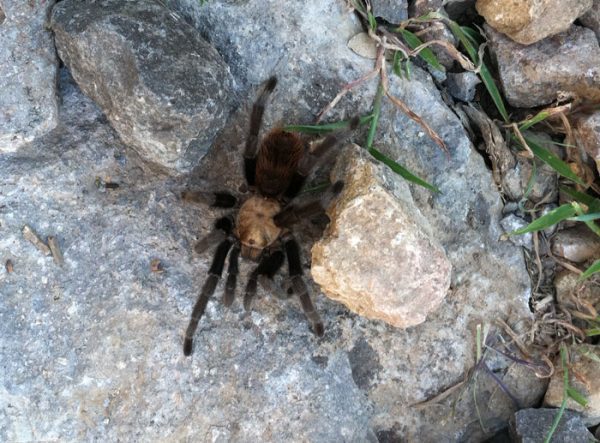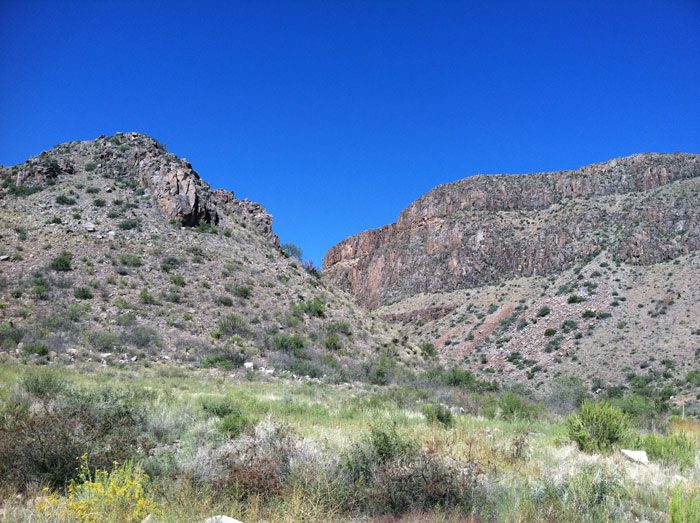Tarantulas – Why’d the spider cross the road?

A few years ago, a woman in the Uwharries called to tell me about a mysterious occurrence she had witnessed. She and her husband were driving home late one evening after a high school football game. Rounding a curve on Okeewemee Road, they saw an owl swoop down and try to snatch a small creature out of the road. Something about the size of a mouse.
They managed to stop in time to see the owl make another attempt. This time, the would-be prey reared up on its back legs, as if to do battle with the hungry raptor. They couldn’t quite make sense of what they were seeing. The creature in the road clearly wasn’t a rodent. In disbelief, they watched it creep into the weeds along the road, somehow escaping the persistent bird.
I listened to the woman’s story intently. When I told her it sounded an awful lot like a tarantula, she laughed with relief, admitting she’d been a little worried I might think she was crazy. Quite the contrary. I applauded her careful observation and lively description of such an unlikely event. Tarantulas aren’t native to the Uwharries, or anywhere east of the Mississippi River for that matter, but her story rang true to me. I’ve had plenty of encounters with tarantulas during my trips to West Texas.
 The first time was in the narrow end of a slot canyon. There was little room to maneuver around the large and hairy arachnid. In general, I’d rather cross paths with a snake than a spider. Serpents are rational. Given the chance, they’d rather slither away or lie there and ignore you. Spiders are unpredictable. You never know when a wolf spider might scamper up your pants leg or an orb weaver might drop down your shirt collar. I started to hurry past the tarantula, but it seemed content to sun itself on a rock. I actually stopped to take a closer look. I wouldn’t want to find one in my tent, but the sight of it didn’t give me the shivers or make the hair stand up on the back of my neck. It was so substantial, I think I subconsciously perceived it as a mammal.
The first time was in the narrow end of a slot canyon. There was little room to maneuver around the large and hairy arachnid. In general, I’d rather cross paths with a snake than a spider. Serpents are rational. Given the chance, they’d rather slither away or lie there and ignore you. Spiders are unpredictable. You never know when a wolf spider might scamper up your pants leg or an orb weaver might drop down your shirt collar. I started to hurry past the tarantula, but it seemed content to sun itself on a rock. I actually stopped to take a closer look. I wouldn’t want to find one in my tent, but the sight of it didn’t give me the shivers or make the hair stand up on the back of my neck. It was so substantial, I think I subconsciously perceived it as a mammal.
Another evening, as we were driving between the visitor center and our campsite in the Chisos Mountains, we noticed a bunch of tarantulas crossing the highway along our route through the high desert. There must have been dozens over the course of just a few miles. I now believe we witnessed one of the mysteries of this species – their periodic mass “migrations.” More study is needed, but it seems this behavior is related to mating. When conditions are right, males will stop at nothing to seek out a female. Perhaps they don’t know there’s a chance she’ll feast on them after the deed.
Tarantulas spend most of their lives underground in burrows. They’re related to our trapdoor spiders in the Piedmont. They don’t spin webs as such, only a few strands of silk to act as a trip wire, which alerts them to the presence of prey. When these nocturnal hunters sense the vibrations of an approaching insect, rodent or amphibian, they bolt from their burrow and grab hold of it with their appendages. They paralyze their victim with venom then inject a digestive enzyme to liquefy the body, allowing the tarantula to slurp its food through straw-like mouth openings.
While their bite proves to be a gruesome fate for their prey, it’s said to be no more bothersome than a bee sting for humans. In fact, many people enjoy keeping tarantulas as pets. Males die within weeks or months after reaching maturity, but females can live up to 30 years in captivity, leading people to joke that if you acquire a tarantula, you’d better make provisions for it in your will.
Our heroic tarantula on Okeewemee Road could have been someone’s pet. It might have been released on purpose or inadvertently escaped. Even though it seemed fearsome, its chance of long-term survival in the wilds of the Uwharries is small. It also could have hitched a ride in the trunk of someone’s car. Or maybe the one of the many tarantulas I’ve encountered in the Big Bend found its way to our campsite and stowed away in my tent.